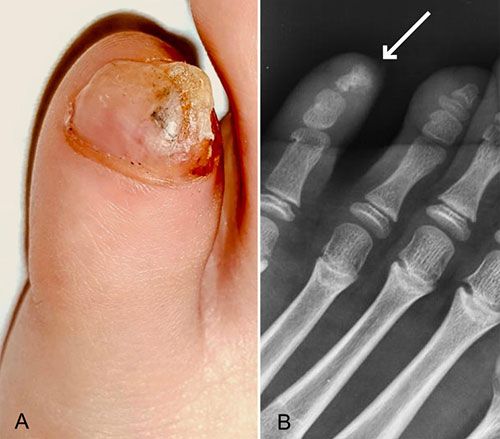An 8-year-old, otherwise healthy boy presented with a 4-month history of
a growing mass under the nail of his right fifth toe, painful on
palpation, which caused onycholysis. The patient denied recent trauma or
occurrence of similar lesions in the past. Family history was
unremarkable. X-Ray showed a dorsomedial exostosis, of
approximately 4×3 mm, on the right fifth toe.
Dupuytren’s subungual exostosis (SE) is a rare
heterotopic ossification that commonly involves the first toe or, more
rarely, other toes or fingers. It usually presents with a solitary,
fixed, painful, sometimes ulcerated or infected dorsomedial mass on the
distal phalanx of toes or fingers, associated with elevation and
dystrophy of the nail plate. The majority of patients are younger than
18 years. Triggers may be trauma or infections. The diagnosis is
confirmed by radiography or histology.
 |
|
Fig. 1 Dupuytren’s subungual exostosis;
(a) mass under the nail of fifth toe causing onycholysis, and
(b) radiograph showing dorsomedial exostosis (arrow).
|
Differential diagnosis includes viral warts, pyogenic
granuloma and osteochondroma. Papillomavirus periungual warts are firm,
keratotic papules which are located around the nail. They can be painful
and cause onycholysis and hyperkeratosis. Pyogenic granuloma, an
acquired benign vascular tumor, appears as a rapidly growing
erythematous, soft, friable nodule with erosive surface and tendency to
bleed under pressure, commonly located on fingers and toes but also in
the head and neck region and oral mucosa. Osteochondroma is clinically
similar to Dupuytren’s SE but radiographically and histologically
different – unlike the latter, in the majority of the cases,
osteochondroma has continuity with the underlying bone and is covered by
hyaline cartilage.
Surgical treatment should aim to preserve the nail
plate; nevertheless, an incomplete excision may lead to recurrence.

